No products in the cart.
NEWS
Mastering Citrus Tree Care: A Gardener’s Essential Guide
Growing citrus trees can be one of the most rewarding experiences for any gardener, bringing the promise of fresh, fragrant blossoms and delicious homegrown fruit right to your doorstep, or even your living room. From vibrant lemons and limes to sweet oranges and tangerines, citrus trees offer year-round beauty and bounty. However, like any plant, they face challenges, including pests, diseases, and specific care needs. Understanding how to properly care for your citrus trees is key to overcoming these obstacles and ensuring a healthy, productive plant. This guide, drawing on expert knowledge and practical experience, will walk you through the essentials of citrus tree care, helping you nurture your trees from planting to harvest and tackle common issues along the way.
The Foundation: Planting and Site Selection
Success begins with the right start. Choosing the appropriate location for your citrus tree is paramount. Citrus trees thrive in sunny spots, requiring at least 6-8 hours of direct sunlight daily to produce abundant fruit. Soil drainage is also critical; citrus roots are susceptible to rot in waterlogged conditions. A slightly acidic soil pH (between 6.0 and 7.0) is generally preferred. If planting in the ground, assess your soil or consider raised beds. For container growing, use a high-quality potting mix specifically formulated for citrus or containers, ensuring the pot has ample drainage holes. When selecting your tree, consider varieties suited to your climate, whether you need cold-hardy options or plan to grow indoors. Popular choices include Meyer lemons for their prolific fruiting and manageable size, or various lime and orange types.
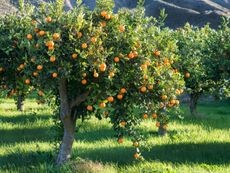 Rows of healthy citrus trees growing in a sunny orchard environment
Rows of healthy citrus trees growing in a sunny orchard environment
Essential Citrus Care Practices
Consistent care is the backbone of healthy citrus trees. Mastering a few core practices—watering, fertilizing, and pruning—will significantly reduce the likelihood of problems.
Watering Wisdom
Proper watering is perhaps the most critical factor in preventing many common citrus tree issues. Citrus trees prefer consistently moist soil, but not soggy conditions. The goal is to water deeply when the top few inches of soil feel dry, allowing the water to reach the entire root zone. Overwatering can lead to root rot, while underwatering can cause stress, leaf drop, and reduced fruit production. Factors like climate, soil type, and whether the tree is in the ground or a container will influence watering frequency. Container-grown citrus, especially indoors, typically requires more frequent watering than trees in the ground.
Feeding Your Trees: Fertilization
Citrus trees are often described as heavy feeders, meaning they require regular nutrient supplementation to support vigorous growth, flowering, and fruiting. A balanced citrus fertilizer, often containing a higher ratio of nitrogen, is essential. Micronutrients like iron, zinc, and manganese are also vital and are frequently included in specialized citrus formulas. Fertilizing frequency and amount depend on the tree’s age, size, and stage of growth, as well as the type of fertilizer used. Applying fertilizer according to package instructions, typically several times during the growing season, helps ensure your tree has the energy it needs to flourish and produce abundant fruit.
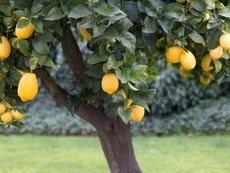 A bountiful lemon tree heavy with many bright yellow lemons ready for picking
A bountiful lemon tree heavy with many bright yellow lemons ready for picking
The Art of Pruning
Pruning citrus trees primarily serves to maintain size and shape, improve air circulation within the canopy, remove dead or diseased branches, and encourage better fruit production. Unlike some fruit trees, citrus often requires minimal pruning. The best time to prune is usually after the main harvest or before new growth begins in spring. Focus on removing suckers (growth from below the graft union), crossing branches, and any wood showing signs of disease or damage. Proper pruning not only keeps the tree healthy but also makes harvesting easier.
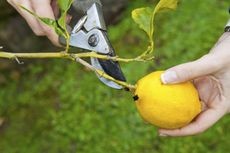 Close-up of pruning shears trimming a branch on a lemon tree during maintenance
Close-up of pruning shears trimming a branch on a lemon tree during maintenance
Navigating Pests and Diseases
Even with the best care, citrus trees can encounter pests and diseases. Early identification and action are key to effective management.
Common Citrus Pests
Various insects find citrus trees appealing. Common pests include aphids, scale insects, mealybugs, spider mites, and citrus thrips. Thrips, for instance, can cause distorted new growth and scarred fruit. Identifying the specific pest is the first step. Often, minor infestations can be managed with natural predators or by washing the affected areas with a gentle stream of water. More significant issues may require horticultural oils or insecticidal soaps. Maintaining a healthy tree through proper watering and feeding makes it more resistant to pest damage.
Recognizing and Managing Diseases
Citrus trees are susceptible to a range of fungal, bacterial, and viral diseases. Some are localized issues, while others, like Citrus Greening (Huanglongbing), are devastating systemic diseases that can kill trees. Key diseases include:
- Citrus Canker: Causes raised, rough spots on leaves, stems, and fruit. Highly contagious, it’s a major concern in many citrus-growing regions.
- Citrus Greening: Characterized by asymmetrical mottling of leaves and small, misshapen, bitter fruit. Spread by the Asian citrus psyllid, there is no cure, and affected trees must often be removed.
- Root Rots: Diseases like Cotton Root Rot or those caused by Phytophthora fungi lead to root decay, wilting, and tree decline. Primarily caused by poor drainage or overwatering.
- Fungal Spots and Rots: Flyspeck fungus or Diplodia stem-end rot can affect the appearance and post-harvest quality of fruit.
Managing diseases often involves preventative measures like choosing disease-resistant varieties, ensuring good air circulation through pruning, avoiding overhead watering, and practicing good orchard hygiene. In some cases, fungicide or bactericide applications may be necessary, but they are most effective when part of an integrated pest and disease management plan.
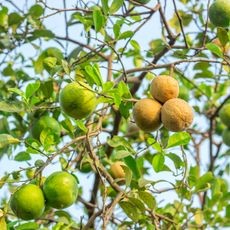 Detailed view of a lemon tree branch exhibiting lesions characteristic of citrus canker disease
Detailed view of a lemon tree branch exhibiting lesions characteristic of citrus canker disease
Troubleshooting Other Common Issues
Beyond pests and diseases, other environmental or nutritional factors can cause problems.
Why Leaves Misbehave: Curl and Drop
Curling leaves can indicate various issues, including pests (like aphids), lack of water, heat stress, or sometimes herbicide drift. Identifying the pattern and checking for insects or soil moisture levels helps pinpoint the cause. Leaf drop can also be a symptom of stress, commonly due to sudden changes in environment (like moving an indoor tree), improper watering (both too much or too little), temperature extremes, or nutrient deficiencies. Consistent care and monitoring the tree’s environment are crucial for preventing these leaf issues.
Fruit Quality Concerns
Sometimes problems manifest directly on the fruit. Oleocellosis, for example, is a non-disease phenomenon causing rind spots, usually due to mechanical injury releasing oils from the peel, often during harvesting or handling, especially when fruit is turgid. Other issues affecting fruit can stem from pests, diseases, or nutritional imbalances, emphasizing the interconnectedness of overall tree health and fruit quality.
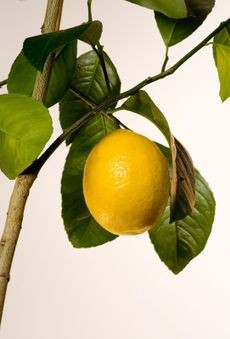 A single ripe Meyer lemon hanging from a branch on a healthy Meyer lemon tree
A single ripe Meyer lemon hanging from a branch on a healthy Meyer lemon tree
Expanding Your Orchard
If you’re feeling adventurous, propagating citrus from seed is possible, though results can be unpredictable, and seedling trees may take many years to fruit or may not produce fruit true to the parent variety. For reliable results and quicker fruit production, purchasing grafted trees or propagating via cuttings or budding is more common.
Citrus Indoors
For gardeners in colder climates, growing citrus trees indoors is a fantastic option. Dwarf varieties like the Meyer lemon or calamondin are particularly well-suited. Indoor citrus requires ample light (supplemental grow lights are often necessary), careful watering (avoiding both drying out and waterlogging), and attention to humidity levels, which are often lower indoors. While fruiting indoors is possible, it may be less prolific than outdoors, but the evergreen foliage and fragrant blossoms still offer significant enjoyment.
 Two dwarf lemon trees growing indoors in pots on a table, suitable for cold climates
Two dwarf lemon trees growing indoors in pots on a table, suitable for cold climates
Conclusion
Mastering citrus tree care is an ongoing journey of learning and observation. By providing your trees with the right light, water, nutrients, and attention to pruning, you create a strong foundation for health and productivity. Understanding common pests and diseases and being prepared to address them promptly will help you protect your valuable trees. Growing citrus, whether a single potted lemon on a patio or several trees in an orchard, offers immense satisfaction. Armed with the knowledge of essential care practices and troubleshooting techniques, you are well-equipped to enjoy the beauty and bounty of your own citrus harvest for years to come. For all your citrus care needs, explore the range of products available at Biogarden.asia.
References
- University Extension Offices (e.g., University of California, IFAS University of Florida)
- Leading Horticultural Resources and Guides
- Agricultural Research Publications
- Experienced Commercial and Home Citrus Growers



